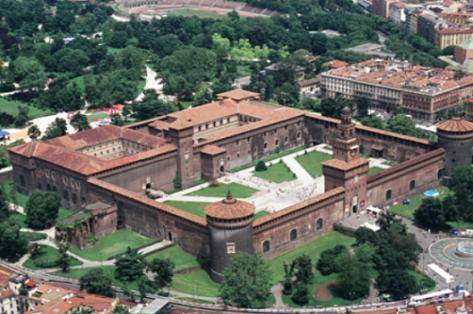 Milan – Western part: Castello Sforzesco
Milan – Western part: Castello Sforzesco
The majestic Castello Sforzesco rises at the end of Via Dante, behind the bus station and Foro Buonaparte, marked out by Napoleon in homage to himself, not having much of the atmosphere of the forum, insanely busy and crowded cars. The Emperor intended to rebuild Milan in the Roman way and create from it the new great capital of Italy, but before losing the city to the Austrians a few years later, he only managed to build an arena, triumphal arch and two semicircular streets around the castle. The arena and the triumphal arch still stand at the back of the castle, at Parco Sempione, a favorite of tramps and prostitutes, while Napoleon's grand plans for the area on the front side of the castle, only left on paper.
A red brick castle, rebuilt many times, with battlemented towers and fortified walls, is the most remarkable building in Milan. Started by Viscontich. was demolished in a year 1447 by the multitudes of , and then rebuilt by their successors, Sforza. During the reign of Lodovic Sforza, the castle became one of the most powerful, the most luxurious and renowned for their wealth of Renaissance manors in Europe. Willing to set new paths also in the field of culture, The Sforzas employed here, among others. Leonard and Bramante. Lodovic's glory days came to an end with the conquest of the city by the French in the year 1499, and from then on, until the end of the 19th century, the castle served as barracks for various occupation forces. Finally, several museums were established here in the last century.
The castle buildings are concentrated around three courtyards. One of them, former residential part of the manor, Ducal Court, it is now adjacent to the Museo d'Arte Antica and the Pinakoteka (Tue-Sun. 9.30-12.15 and 14.30-17.15; Free entrance). The Museo d'Arte Antica has a rather mediocre collection of sculptures from demolished churches and palaces of Milan. Its only decoration is Michelangelo's Pieta Rondanini, on which the artist worked during the last nine years of his life. It is admittedly an unfinished work, but perhaps it is due to the non-smoothing of the marble that the sculpture makes a great impression. An interesting effect is also produced by his "third arm" placed on Christ's right side” hanging limply from the stone mass, which was supposed to suggest a change in the position of his body.
The first room of the Pinakothek on the first floor contains a series of monochrome frescoes, illustrating the history of Griselda of Boccaccio's Decameron. The content of the series is a catalog of humiliations, being tests of fidelity, to whom the marquis surrendered his wife. This series of frescoes was intended to show the patience and piety of a certain Bianchi Pellegrini, whose face can be seen in the first hall of the main gallery, because it served as a model of the figure of the Madonna visible in the Benedetto Bembo polyptych. Bellini's works are on display in the same room, Crivellego, Lippi and one of the last works of Mantegna, dream vision Madonna in glory among angels and saints. Numerous paintings by Vincenzo Foppa were placed in the next room, leading before Leonardo da Vinci, a Milanese artist. It is also worth looking for the DeTatti polyptych, where the castle is an almost fairy-tale background for the crucifixion scene, and puzzling, a portrait of a woman made entirely of flowers, Spring Arcimboldiego, who is considered to be the 16th-century precursor of surrealism.
Other museums are located in the Sforza La Rocchetta fortress, on the left by Corte Ducale. A museum of applied art with musical instruments, wrought iron work, pottery and ivory is not particularly interesting. The little Egyptian dungeon museum is a bit better, which has an interesting arranged exhibition of sarcophagi, mummies and fragments of the Book of the Dead on papyrus. There is also an equally small prehistoric museum, which in the spectacularly illuminated display cases has, among others. a collection of finds from the Iron Age cemetery of the Golasecca culture, south of Lake Maggiore.